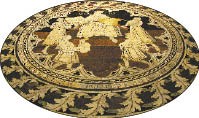
Inside the library of Siena’s Duomo: frescoes to make you gawk like an idiot
It was our last day in Siena, and before we left town I needed to do the Duomo.
“Do” might seem an odd choice of words, as opposed to “experience” or “appreciate,” but each town in Italy has a list of things that must be seen, eaten, photographed, heard, or otherwise … well, “done.” You go to Rome, you do the fountains. In Florence, you do the Uffizi. Pisa, the tower. And I couldn’t face my neighbors or myself if my answer to “Wasn’t the Siena Duomo amazing?” were “Gee, I didn’t do that one.”
So the Duomo would be done. “Duomo” is Italian for cathedral, and each of these towns has one big central church called by that name. And in front of each is the Piazza del Duomo, or “Cathedral Square.” There are lots of other churches in every city, named for one of a trillion saints, and every gathering of seven or more buildings anywhere in Italy also has a church. But each town has but one Duomo.
I hustled over there, since we needed to split town that day. But you must understand some things about these Duomos — or Duomi, I suppose. First, they are very, very large. Motto, motto grande. Second, they were the headquarters of everything during the Renaissance. It was during this time, around the 15th century, that this part of Italy exploded with art and philosophy and culture, all supported by commerce, and each town showed off its stuff in the Duomo. The Siena Duomo is one of the finest around, known especially for the carvings in the marble floor, the frescoes in the library, several bronze statues, the marble pulpit, the high ceiling … it’s a mind-blower. The Duomo in Florence is bigger and has a much larger, more famous dome, but the Siena Duomo, in my best Memphis art-critic voice, whoops Florence’s bad for decoration.
Our guidebook said that nobody really knows when the Duomo was built, but it was somewhere around the 13th century. (In the Mid-South at the time, people were living in mud huts and shooting deer with arrows.) The builders put a new facade on the Duomo at the end of that century, then considered expanding it in a big way during the 14th. But after working on it for 20 years or so, two things happened: They realized the foundation wasn’t big enough — a problem, since the foundation took about a generation to make — and a plague killed three-fourths of the city. Tough to recover from that. To this day, there’s a big square beside the cathedral where you can see a very large, unfinished wall.

Inside Siena’s Duomo
Inside, it’s all about the artwork. The floors are one gigantic, incredibly detailed marble carving — in some places etched like a woodcarving and in others a mosaic of marble. They include scenes from the Bible and from the lives of various saints. The immense columns have bands of white and black marble (echoing the town’s coat of arms). Marble statues, some by Michelangelo and Donatello, fill every nook. Many of the original paintings went off to various museums in the 16th century or were lost, but in a library off to the side, there are frescoes that basically make everybody stand around and gawk like idiots. The colors are fresh, and the room is well-lit, so it’s totally inspiring to walk in there. The scenes — 50 feet tall or more — are painted as if you’re looking into a great hallway, and they show a series of events in the life of a local man whose family commissioned the library (they even had sponsorships back then!) and who eventually became Pope Pius II. There are dramatic scenes of nature and far-away places, and the whole thing invites you to look so long that your neck and back start to hurt.
Having now done the Duomo, I hustled back to the hotel with a revelation. It was a Monday morning, and Siena was back at work. We had been in town for a weekend, and I had complained about the crowds, the lines, the general chaos. But now the number of people in the street had been cut by 80 percent, all the shops were open again, cars buzzed through the streets, and it all felt perfectly normal, comfortable, and inviting.
Of course, we were leaving, bound for that nuthouse known as Florence. But Florence, like the Duomo, had to be done.
portlandpaul@mac.com

